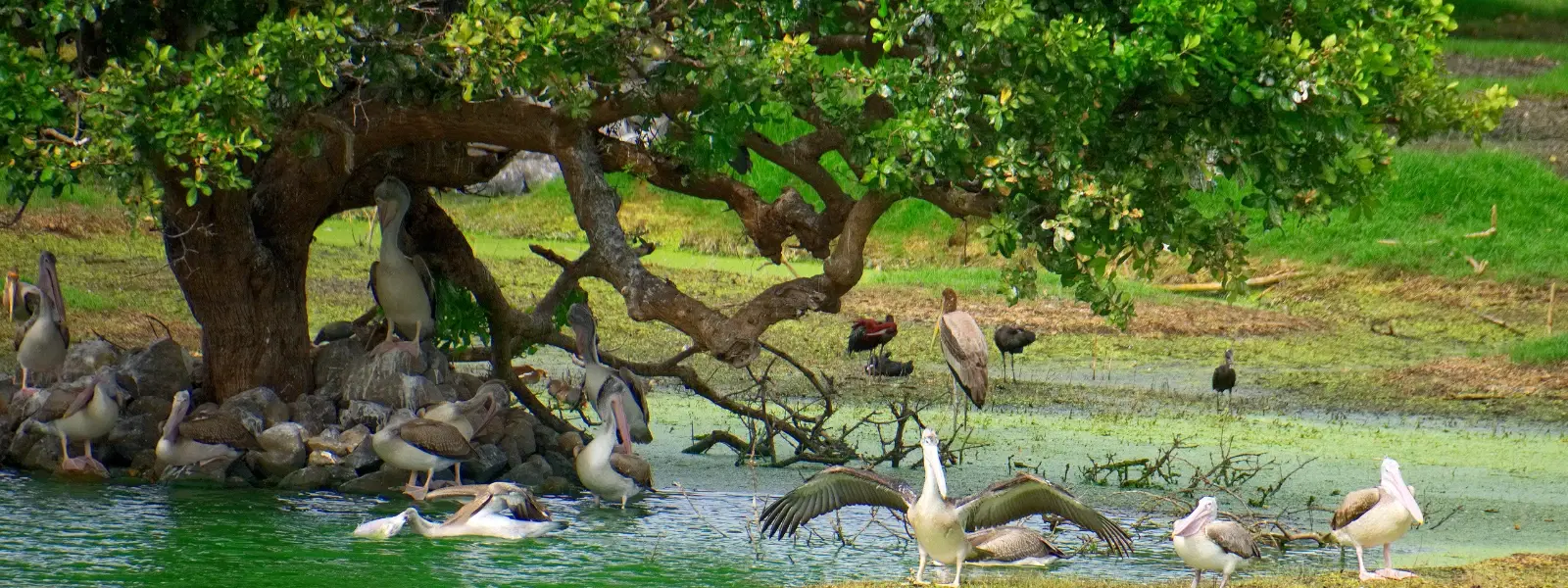
Hotels
•04 min read

Tamil Nadu, a state rich in biodiversity and ecological treasures, offers an unparalleled experience for nature lovers through its bird sanctuaries. In this blog, you will discover the exceptional bird sanctuary in Tamilnadu landscape, explore renowned wildlife sanctuaries in Tamil Nadu, enjoy bird watching in Tamil Nadu, and learn about eco-tourism practices that help protect these natural havens. Our journey spans from understanding the ecological importance of these sanctuaries to practical tips for planning a memorable bird watching expedition.
Tamil Nadu’s rich ecological diversity is showcased through its numerous bird sanctuaries. These protected areas play a pivotal role in conservation by preserving critical habitats for both native and migratory bird species. The interconnected network of wetlands and nature reserves creates a flourishing environment for birds, contributing significantly to the state’s eco-tourism. For travelers ranging from the wanderer looking for spontaneous trips to the planner seeking organized explorations, these sanctuaries provide endless inspiration, while also emphasizing the need to preserve our natural heritage.
Protected areas in Tamil Nadu serve as sanctuaries for a myriad of bird species. These regions, which include internationally recognized Ramsar sites, safeguard wetlands that are critical for birds. They not only offer safe nesting grounds and abundant food sources but also function as a natural laboratory for understanding ecosystems. The protection of these areas is vital for maintaining the balance of nature and ensuring that biodiversity continues to thrive in the region.
Among the many hidden gems that dot Tamil Nadu, some bird sanctuaries capture imaginations immediately. The Vedanthangal Bird Sanctuary, recognized as the oldest bird sanctuary in India, offers a glimpse into the country’s long-standing tradition of nature conservation. Koonthankulam is a paradise for migratory birds, where each season brings in a colorful spectacle of avian visitors. The vibrant avian population at Karaivetti Bird Sanctuary creates a lively atmosphere for nature enthusiasts, while Vaduvoor’s serene settings make it ideal for bird watching and photography.
Beyond the famous sanctuaries lie several lesser-known spots that hide their wonders in plain sight. Vettangudi Bird Sanctuary is a hidden treasure favored by ardent bird lovers for its quiet charm. Sanctuaries like Kanjirankulam and Chitrangudi stand as biodiversity hotspots, offering unique sightings and peaceful surroundings. In addition, Viralimalai Sanctuary, celebrated for its iconic peacocks and serene landscapes, provides a picturesque retreat for anyone looking to escape the hustle and bustle of the city.

Each bird sanctuary in Tamil Nadu is home to a variety of native bird species that play a crucial role in their ecosystems. Painted storks, herons, egrets, and several other indigenous species can be witnessed in these protected areas. These birds not only add to the beauty of the landscapes but also contribute significantly to the ecological balance by functioning as nature’s pest controllers and pollinators.
The state’s extensive network of wetlands acts as a seasonal haven for migratory birds. Every year, species such as flamingos, pelicans, and painted storks set off on long journeys, using Tamil Nadu as a crucial resting and feeding ground. The predictable migratory patterns, especially during the cooler months, transform the sanctuaries into vibrant staging grounds for migratory birds from across continents.
For those eager to experience bird watching in Tamil Nadu, the best time to plan your visit is between October and March when migratory birds grace the sanctuaries in large numbers. Carry essential gear such as binoculars, a camera, and a local bird guide. Always remember to follow the etiquette of keeping noise levels to a minimum and respecting the natural habitat of the birds you encounter.
Eco-tourism in Tamil Nadu is not simply about traveling; it’s about contributing to the preservation of nature. Bird sanctuaries provide opportunities for visitors to participate in conservation activities and learn more about sustainable practices. By engaging with local initiatives, whether through guided tours or community conservation programs, visitors can help ensure the longevity of these protected areas. This responsible travel ethos is especially relevant as efforts continue to support the state’s eco-friendly tourism sector.
Insight Corner: "Did You Know?"
Tamil Nadu is home to 15 officially recognized bird sanctuaries, with plans to establish a 16th sanctuary in the near future. These sanctuaries not only host over 200 bird species but also serve as critical stopovers for migratory birds traveling thousands of kilometers across continents.
The very sanctuaries that are a source of pride today face growing challenges. Habitat loss, pollution, and climate change significantly impact the delicate balance of these natural habitats. Increasing anthropogenic pressures, including urban sprawl and unsustainable land use, continue to threaten the wetlands that serve as safe havens for countless bird species.

Despite these challenges, a wave of conservation initiatives is actively working to preserve these invaluable ecosystems. Both government bodies and local communities are involved in protecting wildlife sanctuaries. Several success stories highlight how coordinated efforts—ranging from sustainable land management practices to environmental education—have helped restore and maintain the biodiversity of Tamil Nadu’s bird sanctuaries. Efforts such as these not only conserve critical bird habitats but also enhance the state’s image as a destination for eco-tourism.
The ideal time is between October and March, when migratory birds are most active.
Tamil Nadu has 15 recognized bird sanctuaries, with plans for further expansion.
Common species include painted storks, pelicans, flamingos, herons, and egrets.
Yes, many sanctuaries offer eco-tourism facilities such as guided tours and dedicated bird watching platforms.
Habitat destruction, pollution, and climate change are the main challenges affecting these areas.
Tamil Nadu’s bird sanctuaries reflect the state’s commitment to preserving its rich natural heritage. They play a crucial role in hosting both native and migratory birds, offer incredible eco-tourism opportunities, and inspire visitors through their breathtaking beauty and biodiversity. By exploring these sanctuaries, travelers not only immerse themselves in a natural spectacle but also contribute to ongoing conservation efforts that protect these invaluable ecosystems.